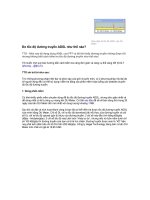Tài liệu Instructor Notes Module 2: Solution - Design Using the MSF ppt
Bạn đang xem bản rút gọn của tài liệu. Xem và tải ngay bản đầy đủ của tài liệu tại đây (87.48 KB, 4 trang )
Instructor Notes Module 2: Solution
Design Using the MSF
Introduction
This module teaches students the Microsoft
®
Solution Framework (MSF)
principles that are used in the rest of the course. Students will learn about
solution design from the perspective of Microsoft’s advocated design process,
the MSF. They will learn the attributes of a good design and how the design
process fits into the MSF Process Model by using the output from one
milestone as the input for the next milestone.
After completing this module, students will be able to:
!
Describe the role of design in developing effective solutions to business
challenges.
!
Describe the MSF Process Model for Application Development.
!
Explain the roles of the conceptual, logical, and physical design phases in
the design process.
!
Explain the benefits of using the MSF Process Model for Application
Development.
Materials and Preparation
This section provides you with the materials and preparation needed to teach
this module.
Materials
To teach this module, you need the following materials:
!
Microsoft PowerPoint
®
file P02_1608a.ppt
!
Module 2, “Solution Design Using the MSF”
!
Activity 2.1, “Identifying Design Principles”
!
Activity 2.2, “Identifying Design Phases”
Presentation:
55 Minutes
Activity:
40 Minutes
2 Instructor Notes Module 2: Solution Design Using the MSF
2 Instructor Notes Module 2: Solution Design Using the MSF
Preparation
To prepare for this module, you should:
!
Read all the module materials.
!
Complete the activity.
!
Read the Library material on the MSF.
!
Understand the overall structure of the MSF Design Process.
!
Be prepared to explain the processes of conceptual, logical, and physical
design by using examples from your own experiences in business solutions
design.
Instructor Notes Module 2: Solution Design Using the MSF 3
Instructor Notes Module 2: Solution Design Using the MSF 3
Activities
Activity 2.1: Identifying Design Principles
After completing this activity, students will be able to:
!
Demonstrate an understanding of the characteristic of good design.
!
To prepare for the activity
1. Complete the activity yourself.
2. Review the suggested solution.
This activity provides students with the opportunity to analyze an item and
identify features that demonstrate principles of good design. Student will also
identify features that appear to be design flaws.
You should prepare several items and perform this sort of analysis yourself.
You might assign a single item to all groups, and discuss the various
perceptions. Alternatively, you might assign each group a different item and
explore the perceptions during the class discussion. Another option is having
each group select an item that is physically present.
Some items to consider are:
!
automated teller machine (ATM)
!
cellular phone
!
automobile dashboard
!
elevator
Questions to Ask Students
Prepare a few questions to ask students to start the class discussion.
!
What are some examples of extremely successful designs?
!
What are some examples of poor designs? What were the costs associated
with the design failure?
The answers to this question can range from automobiles that explode, air
bags that are dangerous to children, to the flaws in the aerospace program.
The costs are numerous as well.
Activity 2.2: Identifying Design Phases
After completing this activity, students will be able to:
!
Demonstrate an understanding of the conceptual, logical, and physical
design phases of the MSF Design Process.
!
To prepare for the activity
1. Complete the activity yourself.
2. Review the suggested solution.
In this activity, students map the design phases to the output of Activity 1.1,
“Identifying Design Steps”. Students take what they have identified as design
steps and fit them in to the MSF Design Process.
4 Instructor Notes Module 2: Solution Design Using the MSF
4 Instructor Notes Module 2: Solution Design Using the MSF
Questions to Ask Students
Prepare a few questions to ask students to start the class discussion.
Module Strategy
Use the following strategy to present this module:
!
Design Overview
This section provides a basic overview of business solution design. Students
learn about well-designed solutions and the cost of poorly designed
solutions.
Make sure that students understand why design is important to a successful
solution.
!
Activity 2.1: Identifying Design Principles
Use this activity to focus students’ attention on the costs of fixing a bad
design and the benefits of investing effort in a good design.
!
MSF Design Process
This section introduces the MSF Design Process that is used throughout the
remainder of the course. Students must have a firm grasp of the concepts of
conceptual, logical, and physical design.
!
Activity 2.2: Identifying Design Phases
Use this activity to solidify students grasp of conceptual, logical, and
physical design and the differences between them. Foster discussion and
consensus on the mapping of the design steps that students identified in
Activity 1.1.
!
Benefits of the MSF Design Process
This section presents some of the benefits of using the MSF Design Process
when designing solutions. Use this section to highlight the benefits, but do
not get lost in the details. This is supporting information.









